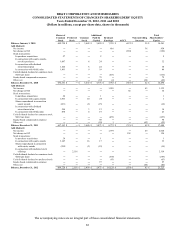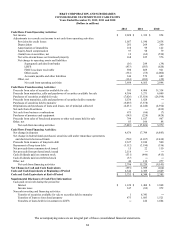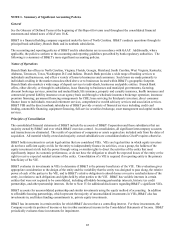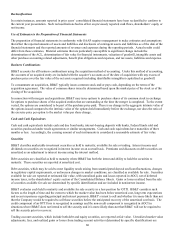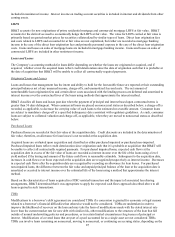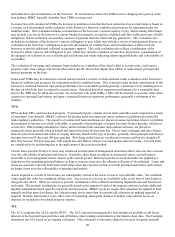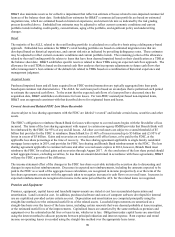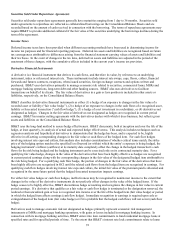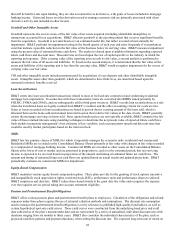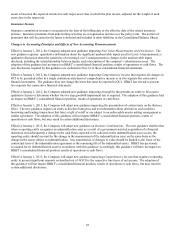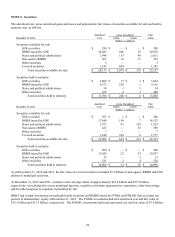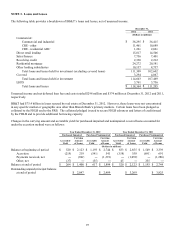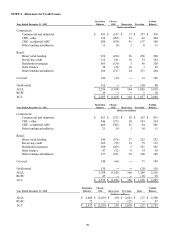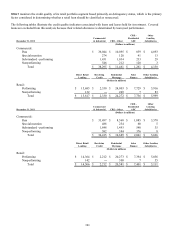BB&T 2012 Annual Report Download - page 114
Download and view the complete annual report
Please find page 114 of the 2012 BB&T annual report below. You can navigate through the pages in the report by either clicking on the pages listed below, or by using the keyword search tool below to find specific information within the annual report.92
that will be held for sale upon funding, they are also accounted for as derivatives, with gains or losses included in mortgage
banking income. Gains and losses on other derivatives used to manage economic risk are primarily associated with client
derivative activity and included in other income.
Goodwill and Other Intangible Assets
Goodwill represents the cost in excess of the fair value of net assets acquired (including identifiable intangibles) in
transactions accounted for as acquisitions. BB&T allocates goodwill to the reporting unit(s) that receives significant benefits
from the acquisition. Goodwill is not amortized over an estimated useful life, but rather is tested at least annually for
impairment. BB&T performs its impairment testing in the fourth quarter of each year and more frequently if circumstances
exist that indicate a possible reduction in the fair value of the business below its carrying value. BB&T measures impairment
using the present value of estimated future cash flows. The analysis is based upon available information regarding expected
future cash flows and discount rates. Discount rates are based upon the cost of capital specific to the industry in which the
reporting unit operates. If the carrying value of the reporting unit exceeds its fair value, a second analysis is performed to
measure the fair value of all assets and liabilities. If, based on the second analysis, it is determined that the fair value of the
assets and liabilities of the reporting unit is less than the carrying value, BB&T would recognize impairment for the excess of
carrying value over fair value.
CDI and other intangible assets include premiums paid for acquisitions of core deposits and other identifiable intangible
assets. Intangible assets other than goodwill, which are determined to have finite lives, are amortized based upon the
estimated economic benefits received.
Loan Securitizations
BB&T enters into loan securitization transactions related to most of its fixed-rate commercial and conforming residential
mortgage loan originations. In connection with these transactions, loans are converted into RMBS issued primarily by
FHLMC, FNMA and GNMA, and are subsequently sold to third party investors. BB&T records loan securitizations as a sale
when the transferred loans are legally isolated from BB&T’ s creditors and the other accounting criteria for a sale are met.
Gains or losses recorded on loan securitizations are based in part on the net carrying amount of the loans sold, which is
allocated between the loans sold and retained interests based on their relative fair values at the date of sale. BB&T generally
retains the mortgage servicing on loans sold. Since quoted market prices are not typically available, BB&T estimates the fair
value of these retained interests using modeling techniques to determine the net present value of expected future cash flows.
Such models incorporate management’ s best estimates of key variables, such as prepayment speeds and discount rates that
would be used by market participants based on the risks involved.
MSRs
BB&T has two primary classes of MSRs for which it separately manages the economic risks: residential and commercial.
Residential MSRs are recorded on the Consolidated Balance Sheets primarily at fair value with changes in fair value recorded
as a component of mortgage banking income. Commercial MSRs are recorded as other assets on the Consolidated Balance
Sheets at the lower of cost or market and are amortized in proportion to, and over the estimated period, that net servicing
income is expected to be received based on projections of the amount and timing of estimated future net cash flows. The
amount and timing of estimated future net cash flows are updated based on actual results and updated projections. BB&T
periodically evaluates its commercial MSRs for impairment.
Equity-Based Compensation
BB&T maintains various equity-based compensation plans. These plans provide for the granting of stock options (incentive
and nonqualified), stock appreciation rights, restricted stock, RSUs, performance units and performance shares to selected
BB&T employees and directors. BB&T values share-based awards at the grant date fair value and recognizes the expense
over the requisite service period taking into account retirement eligibility.
Pension and Postretirement Benefit Obligations
BB&T offers various pension plans and postretirement benefit plans to employees. Calculation of the obligations and related
expenses under these plans requires the use of actuarial valuation methods and assumptions. The discount rate assumption
used to measure the postretirement benefit obligations is set by reference to published high-quality bond indices, as well as
certain hypothetical spot-rate yield curves. These yield curves were constructed from the underlying bond price and yield
data collected as of the plan’ s measurement date and are represented by a series of annualized, individual discount rates with
durations ranging from six months to thirty years. BB&T also considers the individual characteristics of the plan, such as
projected cash flow patterns and payment durations, when setting the discount rate. The expected long-term rate of return on



